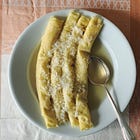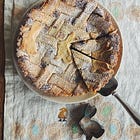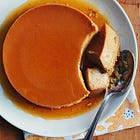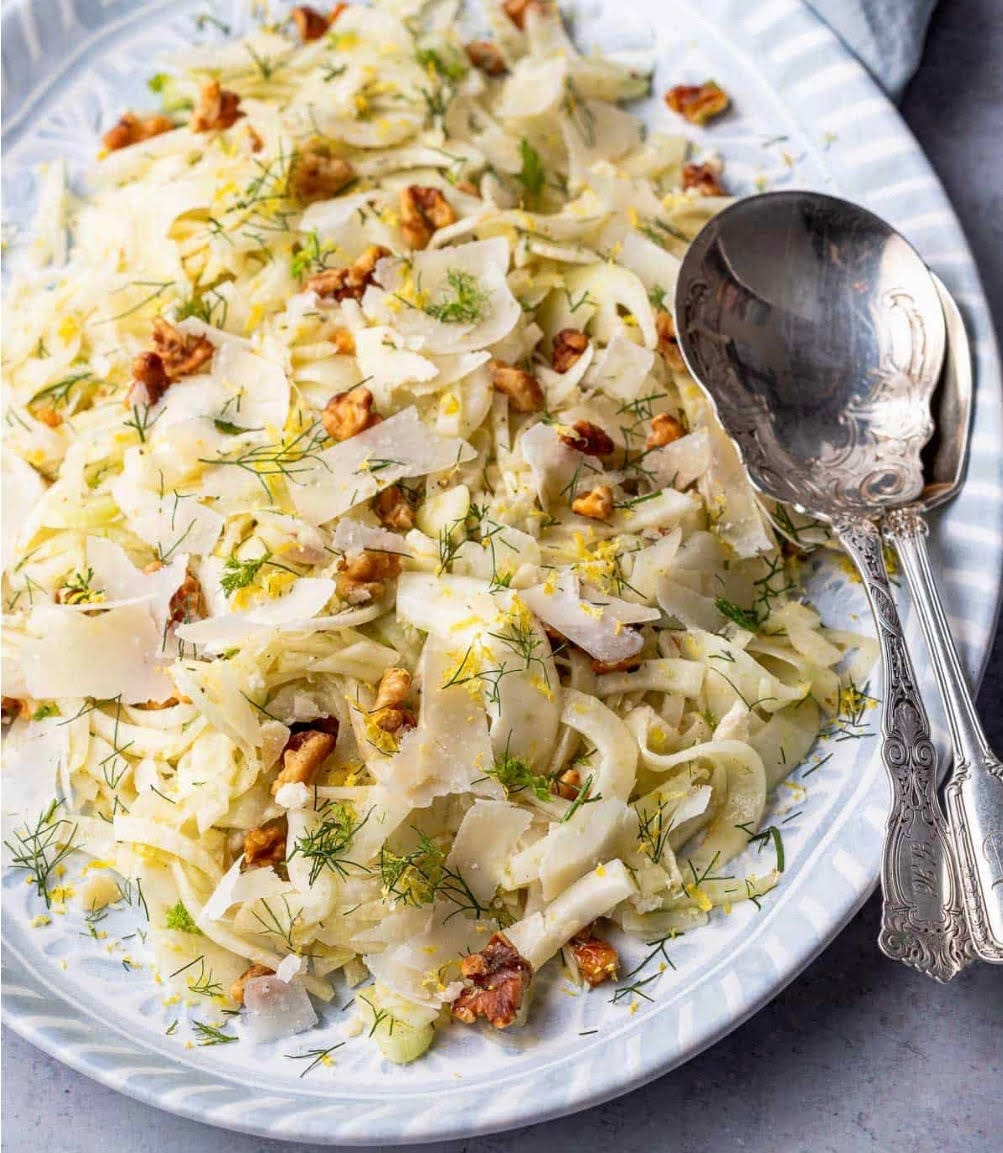C is for Ciambella...
And coffee cake! And celebration! A recipe for the world's best dunking cake, and here's to two years of Buona Domenica

NOTE that today’s newsletter contains links to numerous recipes. To view the entire newsletter, please click on the title at the top to open it in your browser.
Welcome to Buona Domenica, a weekly newsletter of inspired Italian home cooking and baking. I’m a journalist, cooking instructor, occasional tour guide, and author of eight cookbooks on Italian cuisine. Click here to browse through the newsletter archive. If you’re looking for a particular recipe, you’ll find all Buona Domenica recipes—138 and counting—indexed here, ready to download or print—a function for paid subscribers.
A big THANK YOU to all who joined yesterday’s virtual cocktail party/cooking demo for paid subscribers. Looking forward to next time!
Today’s newsletter features a recipe for ciambellone—a classic Italian ring cake and, IMHO, the world’s best dunking cake.
Greetings and a Happy 2nd Birthday to this newsletter!
I am not one to look at numbers, but the Substack dashboard, the platform on which this newsletter is written, kind of makes it hard not to notice them—they are the first thing I see whenever I log in. So, I am a little bowled over to tell you that as of this morning, there are nearly 10,000 of you who have subscribed to Buona Domenica.
I’ll be honest: it’s a milestone I did not expect to reach (and hopefully I’m not jinxing it since we’re not quite there yet). I have long understood that I am a niche presence in the world of food media, even within Italian cooking. I know that the majority of people are not looking for a recipe for fresh egg noodle lasagne with homemade broth and tiny meatballs that are a pain in the arse to roll. I admit that even I rolled my eyes at that one and hesitated before pushing “publish,” wondering who else besides me would bother with such a laborious dish.
And yet, I’ve heard from a handful of you who have bothered with it and are happy to have done so, which thrills me.
If you’ve opened this email, it means you probably know this about me. You know that this newsletter is not about trends; it’s about labors of love and lost recipes and seasonal inspiration and also really good plain food that I make for my family and me and that I enjoy sharing. Thank you for being here.
To celebrate this milestone, this second turn around the sun for Buona Domenica, I’ve baked you a cake. It’s not the cake I originally planned to make. That is a much more elaborate cake, one with a delicate sponge and three different custard fillings requiring nine egg yolks. I will share that cake with you one day, but after recent posts, including the lasagne and an ice cream that also required nine egg yolks, I thought I should give us a break.
So instead, I’m sharing the recipe for my mom Gabriella’s ciambellone, known in our house as “Nonna’s cake” and “the world’s best dunking cake.” If you search “ricetta ciambellone” on Google, most of what comes up are recipes for “ciambellone soffice,” meaning “soft ciambellone,” or “ciambellone soffice soffice,” meaning “really soft ciambellone.” A soft crumb is apparently coveted. But that is not this cake. The crumb for this cake is tender, but it is also dense, sturdy enough to withstand a good dunk in coffee or tea or a glass of cold milk. It is hands down my favorite morning cake, afternoon cake, comfort cake, and dunking cake.
Before we get to the recipe, though, I thought I might share with you my 10 favorite* recipes from the past two years. I’d also love to know: what are yours? Which recipes, if any, have you made? Please let us all know in the comments.
* I reserve the right to change my mind at any given moment
(As most of you know, the majority of recipes I post here are initially free to all subscribers, but go behind a paywall after a month’s time. Since we are celebrating, I have temporarily removed the paywall for all of the links below.)
Domenica’s Ten Favorite* Newsletter Recipes in no particular order
A Few More Links
My latest recipe for The Mediterranean Dish is the Lemony Fennel Salad with Parmesan and Toasted Walnuts pictured above.
I recently appeared on the Italian podcast “Germogli,” an EU-funded project that promotes and seeks to raise awareness about organic agriculture in Europe. The episode focuses on the importance of rural food traditions, in particular farming and food preservation techniques as a more sustainable way of moving agriculture forward. It also touches on the importance of keeping alive the art and craft of preserving as a way of preserving family recipes and history, a subject I delve into in my book Preserving Italy. The podcast creator,
, contacted me after learning about the book. The podcast is in Italian, and I did my best to fumble through, painfully aware of my limited language skills.If you are a lover of Italian amari, or aspire to be, check out this latest post from my friend Nancy of Kitchen Detail blog. Apparently, it was I who turned her into an amaro lover, a fact learned only after reading her post and to which I give an enthusiastic cin cin.
Over on
my friend is taking a deep dive into sourdough pasta this month. This is something I have long been interested in. I’ve been keeping a sourdough starter for about eight years now, but mostly I use it to make focaccia and this sourdough sandwich bread. In truth, my starter is woefully underused and spends most of the time in the fridge, so I’m looking forward to giving it a new purpose by trying some of Chapin’s recipes and techniques.On to this week’s recipe...
Gabriella’s Ciambellone
As with apple cake, there are as many recipes for ciambellone as there are bakers. A ciambella is nothing like an American layer cake; there is nothing fancy about it, and it requires neither frosting nor a fork. This one is sturdy, with a dense crumb, though somehow still tender—almost fudgy. It's an excellent breakfast cake and good for an afternoon snack, too. It is, in fact, the perfect dunking cake, whether you are dunking in cappuccino, American coffee, tea, or a glass of cold milk.
This recipe calls for Punch Abruzzo, a sweet, strong liqueur made from caramelized sugar and the zest of lemons and oranges. It’s not easy to find outside of Italy, so just substitute rum (see NOTES).
My mother made this cake the "old-fashioned" way; that is, she mounded the dry ingredients on the countertop as though she were making pasta, and worked in eggs, softened butter, and cream with her hands to form a very soft dough. I use a bit less flour than she did, and so the batter is too sticky to work on the counter. I use a stand mixer instead, which works just as well.
Makes one 10-inch (25-cm) ring cake
INGREDIENTS
6 cups (750 g) unbleached all-purpose flour, plus additional for dusting the tube pan
1/4 teaspoon fine salt
1 tablespoon baking powder
2 teaspoons baking soda
3 cups (600 g) sugar
6 large eggs 1 cup (230 g; 2 sticks) unsalted butter, softened to room temperature and cut into 1/2-inch cubes, plus additional for greasing the tube pan
1/2 cup (120 ml) whole milk, light cream, or half-and-half
2 teaspoons pure vanilla extract
1/4 teaspoon pure almond extract
2 tablespoons Punch Abruzzo liqueur or dark rum (see NOTES)
2 tablespoons Swedish pearl sugar or granulated sugar for sprinkling (see NOTES)
INSTRUCTIONS
1. Heat the oven to 350° F (180° C). Butter and flour a 10-inch (25-cm) ring or tube pan and set aside.
2. In a large bowl, whisk together 6 cups (750 g) flour, the salt, baking powder, and baking soda. Set aside.
3. Combine the sugar and eggs in the bowl of a stand mixer fitted with the whisk (or paddle) attachment. Mix on low to break up the eggs, then beat on medium-high to incorporate them into the sugar. Scatter the softened butter around the bowl and mix until the butter is incorporated. Your aim is not to aerate the mixture too much—it doesn’t need to be fluffy—but make sure the butter is well worked in. Add the milk, vanilla and almond extracts, and Punch or rum, and beat just until incorporated.
4. Pour in the dry ingredients and mix on low, turning the mixer on and off at first to prevent the flour from kicking up. Beat on medium until the flour is incorporated but take care not to over-mix or your cake will end up tough. Alternatively, use a sturdy spatula to stir in the flour mixture by hand, mixing until fully incorporated. The batter will be heavy, dense, and sticky.
5. Scoop the batter in big dollops into the prepared baking pan, and smooth out the top with a spatula. Sprinkle the pearl sugar on top. Bake the cake in the middle of the oven for 20 minutes. Lower the heat to 325° F (160° C) and continue to bake for another 25 to 30 minutes, or until it has risen and is browned on top, but not quite set. If the top seems to be browning too much before the cake is done, cover it lightly with a sheet of foil. The cake is done when a skewer inserted into the center comes out clean.
6. Transfer the pan to a rack to cool for 20 to 30 minutes. Remove the cake from the pan and set it, sugared-side-up, to cool to room temperature before slicing.
NOTES
This recipe can be halved. Use an 8-or 9-inch (20- or 23-cm) tube pan. Bake for 20 minutes at 350° F (180° C); then lower the heat to 325° F (160° C) and bake for another 15 to minutes, until a skewer inserted into the center comes out clean.
Punch Abruzzo is produced outside of Chieti, my mother's hometown. It is a sweet, potent liqueur made from caramelized sugar and the zest of lemons and oranges. There are two main producers: Evangelista and Jannamico. Both are good, though I have a slight preference for Evangelista since it’s the brand my parents bought when I was growing up, and also for the charming alpine ski scene on the label. Punch is not always easy to find. Here is an online source for Jannamico. Unfortunately, buying Evangelista brand online seems to be prohibitively expensive. Punch is a popular after-dinner digestivo but I sometimes think its true purpose is for drizzling over vanilla ice cream (or adding a splash to French toast batter). If you are unable to find it for the cake, substitute dark or Jamaican rum (mixed with a little orange and lemon zest, if you like).
Swedish pearl sugar consists of bright white, irregularly shaped granules of sugar. It is often used as a decorative touch in European baked goods and is available online at King Arthur Baking.
PICTURE ITALY: Lucca, 2018
Thanks to all for your support. Please keep sharing the love for Italian cuisine by clicking the little heart at the top of this newsletter and by subscribing and sharing.
Alla prossima,
Domenica





















Buon compleanno! You have been important in my kitchen for years. I recently reviewed all of your cookbooks for winter inspiration. Though I love them all, Preserving Italy remains my favorite.
Thank you for your Ciambella cake recipe, I'm looking forwaed to making it.
However, I cant access the other recipes from which you have temporarily taken the paywall.
. Was that for only a few hours, and Ive checked my emails too late ?xx